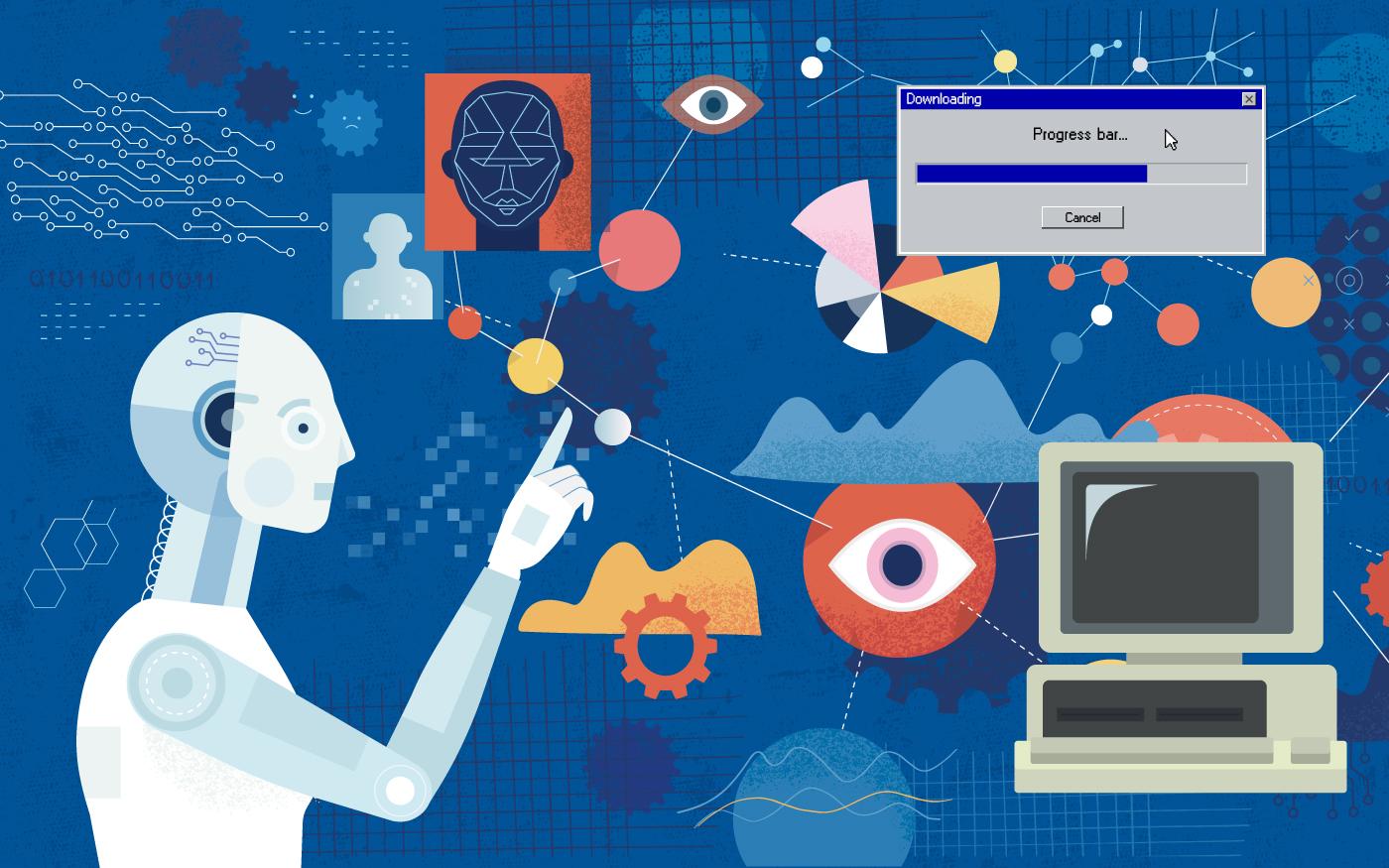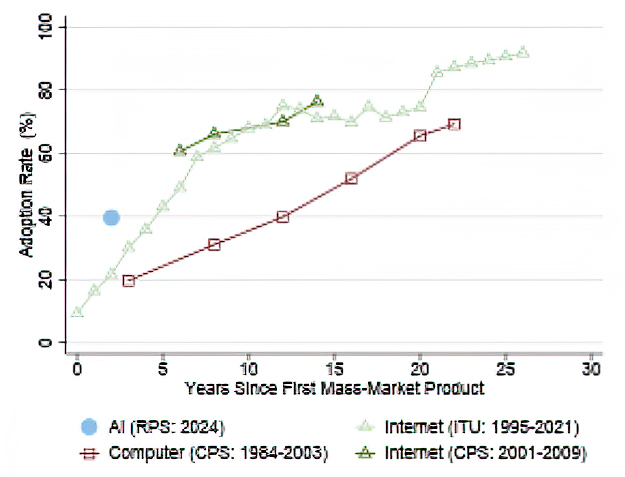
From Dial-Up to Data Centers: A Look Back to Understand What’s Ahead
Two Technological Shifts, 25 Years Apart
During the late 1990s and early 2000s, the introduction of the internet changed how the world communicated, did business, and shopped. Now, almost a quarter century later, Artificial Intelligence (AI) has proven to be the next transformative technological advancement. While these two revolutions are not nearly identical, I believe comparing them can provide some valuable insights that can be used today. In this blog we’re going to explore the similarities and differences between these technological changes and what takeaways investors may draw from history to better navigate the markets today.
Adoption at Scale
In the early 2000s, the internet took well over a decade to obtain widespread adoption.[GU1] [GU2] [GU3] Online search, e-mail, and e-commerce grew slowly, being limited by dial-up access and significant hardware costs. On the other hand, AI tools like ChatGPT reached one million users in only five days! Compare this to the first mass market internet service provider, America Online (AOL), which took nine years to reach one million users.
Comparing Adoption Rates

This chart shows how quickly generative AI has been adopted relative to the internet and personal computers.
Source: NBER
Why such a big difference? AI can run on cloud infrastructure that already exists. On top of that, the software, smartphones, and platforms being used today can be easily integrated with AI at the touch of a button. When compared to the internet era, AI offers a much quicker time to benefit as these products can be directly integrated into current workflows and provide the ability to reap productivity benefits in weeks rather than years. In the early days of the internet, companies had to completely transition from a paper-based system to a new digital process that took years to understand fully.
This quicker adoption curve explains why, unlike the internet boom, where funding went to speculative IPOs, capital today flows into tech giants with the infrastructure that allows them to scale AI efficiently.
Capital Investment: Speculative Startups vs Mag 7
During the dotcom boom, capital investments were flowing into telecom infrastructure, startups, and speculative ventures such as Pets.com, Webvan, and Cosmo.com with little to no business history or proven business models. Many of these startups and speculative ventures were then able to go public with an unsustainable business model and little to no revenues, taking advantage of the inflated market expectations, resulting in the dot-com crash of the 2000’s. [GU4]
Today, these artificial intelligence capital flows look a bit different. While investments in AI are still substantial, it’s driven by large, established, profitable companies that already have proven business models. A few of the most prominent companies in this space have committed more than $300 billion to build data centers and improve chips, with a significant amount of that spending expected to be done in 2025. While startups are still receiving funding through this AI boom, it is much more centralized and less speculative. That said, a large sum of concentrated capital does not completely reduce risk and while expectations for AI remain high, only time will tell if these expectations eventually get met.
Big Tech's Capex Soars as AI Investment Accelerates

This chart shows the estimated capex of four of the seven Mag 7 companies through 2025.
Source: Financial Times
Infrastructure Differences: Bandwidth vs Compute
The internet boom required a grand buildout of fiber optic cables, broadband, and basic web servers. Today’s Artificial Intelligence revolution is dependent on a completely new kind of infrastructure: computing power and energy. Training and running AI models require vast amounts of GPUs and power-hungry data centers, many of which now consume more energy than entire neighborhoods. Forecasts made by the World Economic Forum suggest that these energy demands will significantly increase in the next five years as the models become more complex and widely adopted across several industries. To address this issue, companies involved in the AI buildout have not been investing in just hardware, but in energy efficient chips and cooling systems so that they are able to sustainably support the AI buildout. The shift in infrastructure needs is not only changing how companies allocate capital, but how the market is valuing these companies that are supplying the “picks and shovels” of Artificial Intelligence.
Market Skepticism
During the internet boom, investor sentiment was mainly driven by skepticism and fear of missing out. The public markets saw an influx of IPO’s and investors rushed to invest in these companies based on brand recognition rather than fundamentals, suffering losses when the market corrected. Today, AI enthusiasm is a bit more grounded. Investors aren’t pouring into speculative IPO’s, rather they are flowing into large-cap tech companies that have proven revenues, sustainable business models, and consistent revenue growth through the AI expansion. There is also much more caution. Investors are now looking for tangible outcomes such as margin improvements, productivity gains, and top-line growth. While expectations are still high for Artificial Intelligence, the market appears more focused on real outcomes compared to previous periods of speculative growth.
Nasdaq Price Performance (# of Years)

Chart showing normalized Nasdaq (IXIC) price performance during the Ai bubble (Jan 1st, 1993 – December 31st 2002) and Dotcom Boom (Jan 1st 2016 – July 18th 2025) This chart is for illustrative purposes only and does not represent actual investment performance or a specific investment strategy.
Source: Ycharts
Conclusion
Looking at the parallels between the dotcom boom and today’s AI boom can help provide a better understanding of what is currently unfolding in markets. By comparison, we can see the differences in adoption speed and why it is much easier for companies to implement AI today. Unlike the internet boom, where companies had to completely adopt a new technological system. Secondly, this time around the companies that are receiving funding are distinguished large cap companies, completely different from the Internet era which had an influx of IPO’s receiving a substantial amount of funds. Thirdly, the internet era required massive investment into broadband and fiber optics to connect users, but this AI boom is placing stress on a completely new type of infrastructure in compute power, electricity needs, and cooling these high-performance systems. Lastly, investor behavior this time around is more grounded in fundamentals and real company improvements rather than hype and brand recognition. Unlike the 90’s, today’s boom is built upon an already existing foundation, capital is pouring into proven companies, and investors are looking for tangible proven outcomes. Although, it will inevitably lead to the displacement of jobs in certain sectors, much like any other transformational technology, it will also create entirely new industries and jobs that aren’t yet fully imaginable. While all the excitement around AI is not all hype, the real test is whether this innovation will continue to add value across sectors over time.
Key Differences Between Dotcom and AI Boom:
- Adoption: AI adoption is much faster thanks to existing cloud infrastructure
- Capital Flows: Investments are concentrated in large-cap proven tech companies
- Infrastructure: The AI era is reliant on energy intensive compute power, not broadband
- Investor Behavior: Investment decisions rooted in tangible outcomes not skepticism
At KWB Wealth, we have observed how Artificial Intelligence tools can enhance productivity and efficiency. We intend to explore ways to use this technology in support of our clients' long-term planning efforts. Learning from past cycles, staying focused on fundamentals, and following a financial plan can help investors better position their portfolios and navigate future uncertainties with confidence.
~ KWB Team
